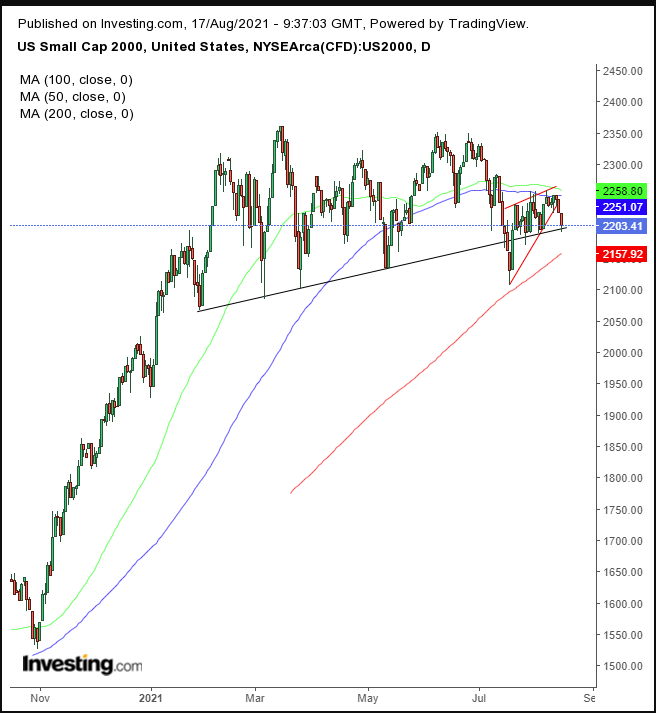On Tuesday, global stocks sold off for a second day. At time of writing, US futures for all four major indices were also falling, with contracts on the Russell 2000 leading the declines.
Though the S&P 500 and Dow Jones Industrial Average notched new all-time highs during Monday's Wall Street session, that wasn't the case for the small cap Russell 2000 index. Rather, the benchmark slumped for the third straight session.
Cyclical stocks worldwide are leading the decliners, and stocks listed on the Russell 2000 are in that sweet spot.
Companies included on the Russell 2000 represent value shares—smaller, domestic businesses that were hammered during pandemic lockdowns, when consumers couldn't engage with those establishments. After Americans grew tired of spending on their homes and making purchases via technology, and as vaccines were being rolled out, the Reflation Trade lifted beaten down value stocks which had been depressed during last year’s recession.
Recently, value shares outperformed growth stocks, predominantly tech industry companies that had thrived in a stay-at-home world. Since the March 2020 low, the Russell 2000 index is up 128%. It had been as high as +144% as of March 2021, displaying some of the most fantastic returns in the history of the stock market.
But the Delta variant of COVID continues to surge and social restrictions around the world are being reinstated. Investors are wondering whether shares of the pandemic darlings could be the stocks now worth betting on. The jury is still out on that one, but here's what technicals for the Russell 2000 are signalling:

The index's three-day selloff completed a rising wedge, bearish after the preceding five-day straight decline. That occured because dip buyers gave up and cashed out, leaving only bears in the fray.
Note: the wedge developed precisely between the 100 and 200 DMAs, making it a technical pressure point on the chart. Furthermore, the wedge formed right on the neckline of large top, which has been ranging since the beginning of the year.
If the bearish dynamic within the wedge follows through as expected, it will push the benchmark below the 200 DMA, and perhaps more significantly, below the July 19 low, which turned out to be a bear trap. A new low would cement the downtrend.
Trading Strategies – Short Position Setup
Conservative traders should wait for the price to decisively complete the top, as described above.
Moderate traders would short upon a return move that finds resistance by the wedge.
Aggressive traders could short at will, provided they understand the added risk of moving ahead of the market and are trading according to a tight, preset plan, they are committed to. Here’s an example:
Trade Sample
- Entry: 2,203
- Stop-Loss: 2,253
- Risk: 50 points
- Target: 2,003
- Reward: 200 points
- Risk:Reward Ratio: 1:4
Author's Note: This is just a sample. And it isn’t necessarily the one, true way to approach this trade. It’s also not the analysis. That’s in the body of the text. If you haven’t read and understood it, do NOT attempt to trade it. Even if our analysis is spot on, it is based on statical past performance. Investors don’t behave the same way each time so statistics from past performance can only be somewhat predictable overall. Plus, of course, our analysis could be wrong.
The objective of a professional trader is not to win each trade. That's impossible. All they're trying to do is manage their luck as they operate along statistical results and hope to win overall. Before you enter a trade, close your eyes, and imagine the trade losing. If you can’t handle that, do NOT enter the trade. Your trade plans must incorporate your budget, temperament and timing. Until you learn how to write a tailored plan, feel free to follow ours, for the purpose of learning, not profit. Or you will end up with neither. Guaranteed. And there's no money back.
